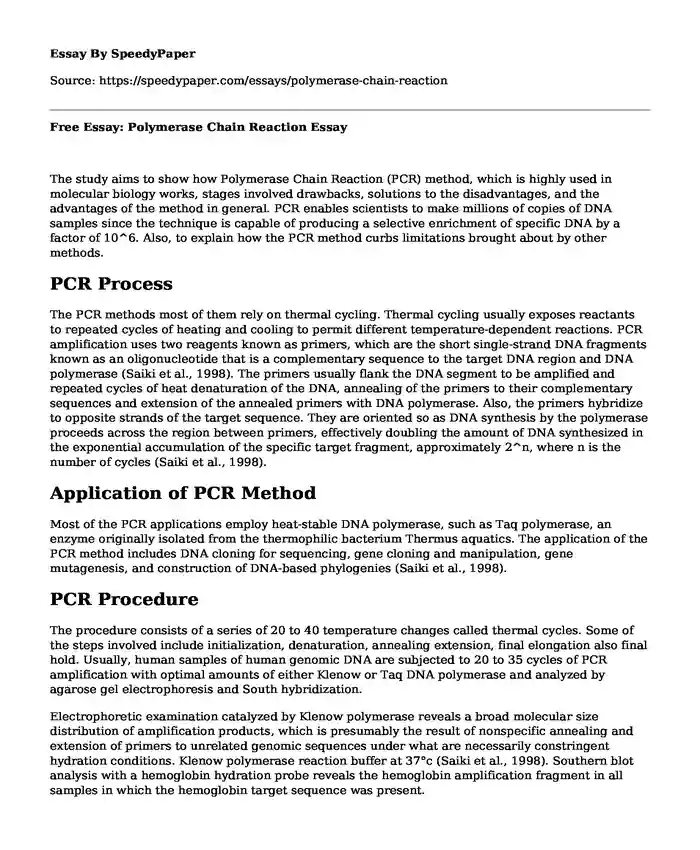The study aims to show how Polymerase Chain Reaction (PCR) method, which is highly used in molecular biology works, stages involved drawbacks, solutions to the disadvantages, and the advantages of the method in general. PCR enables scientists to make millions of copies of DNA samples since the technique is capable of producing a selective enrichment of specific DNA by a factor of 10^6. Also, to explain how the PCR method curbs limitations brought about by other methods.
PCR Process
The PCR methods most of them rely on thermal cycling. Thermal cycling usually exposes reactants to repeated cycles of heating and cooling to permit different temperature-dependent reactions. PCR amplification uses two reagents known as primers, which are the short single-strand DNA fragments known as an oligonucleotide that is a complementary sequence to the target DNA region and DNA polymerase (Saiki et al., 1998). The primers usually flank the DNA segment to be amplified and repeated cycles of heat denaturation of the DNA, annealing of the primers to their complementary sequences and extension of the annealed primers with DNA polymerase. Also, the primers hybridize to opposite strands of the target sequence. They are oriented so as DNA synthesis by the polymerase proceeds across the region between primers, effectively doubling the amount of DNA synthesized in the exponential accumulation of the specific target fragment, approximately 2^n, where n is the number of cycles (Saiki et al., 1998).
Application of PCR Method
Most of the PCR applications employ heat-stable DNA polymerase, such as Taq polymerase, an enzyme originally isolated from the thermophilic bacterium Thermus aquatics. The application of the PCR method includes DNA cloning for sequencing, gene cloning and manipulation, gene mutagenesis, and construction of DNA-based phylogenies (Saiki et al., 1998).
PCR Procedure
The procedure consists of a series of 20 to 40 temperature changes called thermal cycles. Some of the steps involved include initialization, denaturation, annealing extension, final elongation also final hold. Usually, human samples of human genomic DNA are subjected to 20 to 35 cycles of PCR amplification with optimal amounts of either Klenow or Taq DNA polymerase and analyzed by agarose gel electrophoresis and South hybridization.
Electrophoretic examination catalyzed by Klenow polymerase reveals a broad molecular size distribution of amplification products, which is presumably the result of nonspecific annealing and extension of primers to unrelated genomic sequences under what are necessarily constringent hydration conditions. Klenow polymerase reaction buffer at 37°c (Saiki et al., 1998). Southern blot analysis with a hemoglobin hydration probe reveals the hemoglobin amplification fragment in all samples in which the hemoglobin target sequence was present.
The different electrophoretic pattern is seen in the amplification performed with Taq DNA polymerase, where the single predominant band is the 167-bp target segment. This specificity is due to the temperature at which the primers are extended, the annealing step performed at 40°c, the temperature of Taq polymerase catalyzed reactions was raised to about 70°c (Saiki et al., 1998). Poorly matched primer-template hybrids formed at 40°c are dissociated. The only highly complementary substrate remains at the reaction to the catalysis stage. Increased specificity makes nonspecific extension products to compete for the polymerase, and yields are usually higher.
Then the leveling-off stage, whereby the level of amplification is reached, the more primer-template substrate has accumulated than the amount of enzyme present is capable of completely extending in the allocated time (Saiki et al., 1998). This makes the efficiency of the reaction to declining, the amount of PCR product accumulates in a linear rather than an exponential manner. Then the last stage is a plateau; this is where no more product accumulates due to exhaustion of reagents. The specificity improvement is obtained when the temperature of the primer annealing step is raised from 40°c to 55°c (Saiki et al., 1998).
Factors Influencing the Specificity of Taq Polymerase Catalyzed Amplification
Electrophoretic analysis of specificity as affected by increasing extension times 0,0.5,2 and 8 minutes (1 to 4, respectively).
Drawbacks
Klenow fragment thermolability of Escherichia coli DNA polymerase 1. used to catalyze the extension of the annealed primers. Since the heat denaturation step is required to separate the newly synthesized strands of DNA, the new enzyme must be added during each cycle. The process is prone to error, especially when several samples are amplified.
Solution to Drawbacks
DNA polymerase is replaced by Thermostable DNA polymerase purified from the Thermophilic bacterium 'Thermus aquatics (Taq) since it can survive extended incubation at 95°c.no need to replenish at every stage since heat-resistant polymerase is relatively unaffected by the denaturation step.
Reference
Saiki, R. K., Gelfand, D. H., Stoffel, S., Scharf, S. J., Higuchi, R., Horn, G. T., Erlich, H. A. (1988). Primer-directed enzymatic amplification of DNA with a thermostable DNA polymerase. Science, 239(4839), 487-491.
Cite this page
Free Essay: Polymerase Chain Reaction. (2023, Aug 02). Retrieved from https://speedypaper.net/essays/polymerase-chain-reaction
Request Removal
If you are the original author of this essay and no longer wish to have it published on the SpeedyPaper website, please click below to request its removal:
- Free Essay on The Oak Ridges Moraine
- Dental Hygienist - Personal Statement Essay Example
- Essay Example Dedicated to the Age of Enlightenment: Reason and the Reformation of Society
- Essay sample on Aviation History
- What the Survey Will Reveal. Paper Sample
- Essay Sample on Why Should Christians Study Secular Literature Discussion
- Paper Example: Probability of Obtaining Heads on a Coin Toss
Popular categories





